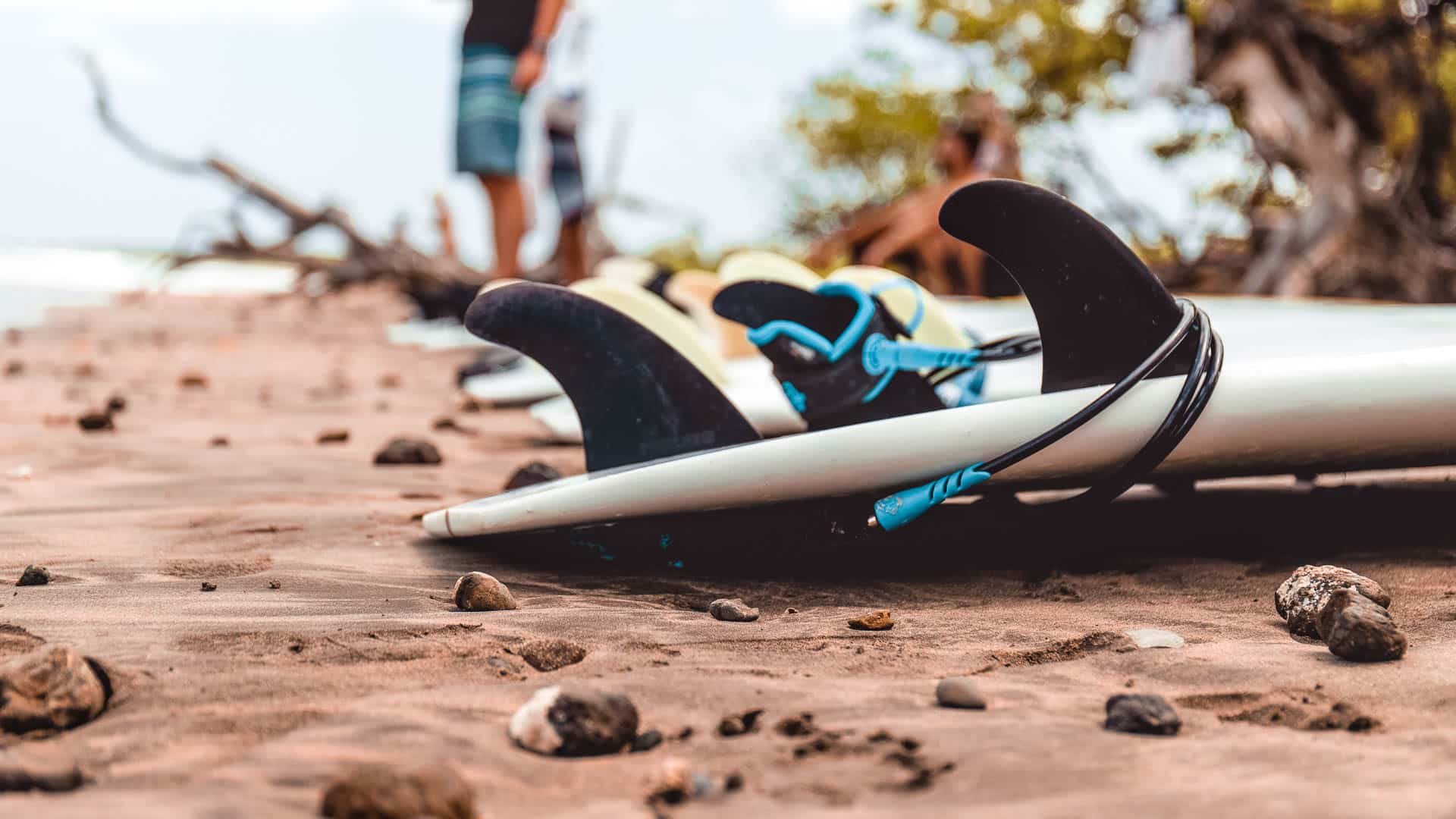Surf booties, also known as surf shoes or water shoes, are specialized footwear designed for surfing, bodyboarding, and other water sports. They are typically made of neoprene, a material that provides warmth and protection from the cold water, and also offers a snug fit for added comfort and flexibility. Surf booties are available in different sizes and thickness to accommodate various foot shapes and water temperature conditions.
These booties are equipped with a durable sole that provides grip and traction, allowing the surfer to maintain stability on the board and while walking on slippery surfaces, such as rocks or reefs. The closure options for surf booties include Velcro, drawstrings, and laces. Velcro closures are convenient and easy to adjust, making them a popular choice for surfers. Drawstrings, on the other hand, offer a secure and customizable fit. Laces provide the most secure closure, ensuring that the booties stay on the feet during the most rigorous activities. Each closure option serves the function of keeping the booties in place and preventing water from entering, ultimately enhancing the surfer’s performance and overall experience in the water.
Benefits Of Surf Booties
There are different features and types of surf booties available, such as grip technology for better traction on the board, ankle straps for added security and custom fits for maximum comfort and support.
- Protection: Surf booties are designed to protect your feet from sharp rocks, coral, and other hazards in the water, reducing the risk of injury while surfing.
- Warmth: Surf booties provide insulation to keep your feet warm in cold water, allowing you to stay in the water longer and maintain body heat during chilly surf sessions.
- Improved surfing performance: The added grip and stability from surf booties can enhance your balance and control on the board, improving your overall surfing performance.
Surf booties help prevent injuries by providing a protective layer between the feet and potential hazards in the water, reducing the risk of cuts, abrasions, and puncture wounds. Additionally, the improved traction on the board helps prevent slips and falls, reducing the likelihood of foot and ankle injuries. The added warmth and insulation also increase comfort, allowing surfers to focus on their performance without being hindered by cold feet or discomfort.
Wearing surf booties is important for both beginner and experienced surfers. Beginners can benefit from the added protection and improved traction while learning the ropes of surfing, helping them feel more confident and secure in the water. Experienced surfers can also benefit from the warmth, protection, and traction provided by surf booties, allowing them to perform at their best in various surfing conditions. Overall, surf booties are essential for ensuring a safe, comfortable, and enjoyable surfing experience for all levels of surfers.
What Are Surf Booties Made Of?
Surf booties are typically made from neoprene, a synthetic rubber material that is widely used in wetsuits and other water sports accessories. Neoprene provides excellent insulation, keeping the feet warm in cold water, and offers good flexibility for a comfortable fit. However, neoprene is not the most environmentally friendly material, as it is derived from petroleum.
Yulex is a newer alternative to neoprene, made from natural rubber derived from the guayule plant. It offers similar insulation and flexibility as neoprene but with a lower environmental impact. Yulex is also hypoallergenic, making it a great option for those with sensitive skin.
In addition to the material used, surf booties often come with additional features to combat cold water, such as reinforced soles for added protection and grip, and thermal linings to further enhance insulation. These features are essential for keeping the feet warm and comfortable in chilly ocean or lake waters.
In summary, both neoprene and Yulex are popular materials for surf booties, offering insulation and flexibility, with Yulex being a more sustainable option. The inclusion of reinforced soles and thermal linings further enhances the functionality of surf booties in cold water conditions.
Who Should Wear Surf Booties?
Surfers, swimmers, and water sport enthusiasts are the specific groups of people who need surf booties. Surfers need them to protect their feet from cold water and sharp rocks while paddling out to catch waves. Swimmers can benefit from surf booties to keep their feet insulated and protected from the elements, especially in colder water conditions. Water sport enthusiasts, such as kayakers and paddleboarders, also need surf booties to prevent slips and falls on slippery surfaces and to shield their feet from potential hazards in the water.
These individuals specifically need surf booties for the protection they provide against cold water, sharp rocks, and other elements. Surf booties offer insulation and keep feet warm in cold water, and their durable construction shields feet from sharp rocks and other potential hazards in the water.
The benefits and features of surf booties that make them essential for these activities include their non-slip soles, comfortable fit, and durable materials. They provide added traction and stability on slippery surfaces, while also offering cushioning and protection for the feet. Overall, surf booties are indispensable for surfers, swimmers, and water sport enthusiasts, as they provide essential protection and support in various water activities.
Risks Of Not Wearing Surf Booties
If you choose not to wear surf booties while surfing, you are putting yourself at risk for a variety of potential consequences. Without the protective barrier of surf booties, you are more likely to sustain cuts and scrapes from sharp coral and rocks in the water. Additionally, without the insulation provided by surf booties, your feet are at risk of quickly becoming cold in cold water conditions, which can lead to discomfort and decreased mobility.
Furthermore, not wearing surf booties increases the likelihood of getting stung by jellyfish or stingrays, which can result in painful injuries and potential health complications. By wearing surf booties, you can minimize the risk of injury and discomfort while enjoying your time in the water.
Different Types of Surf Booties
There are three main types of surf booties commonly used by surfers: round toe, split toe, and internal split toe.
Round Toe: The round toe surf booties are the most traditional and common type. They feature a rounded toe design and provide good overall warmth and protection. They are also known for their durability and are a great option for general surfing in mild to moderate conditions.
Split Toe: Split toe surf booties have a separate compartment for the big toe, which allows for better grip and control on the board. This design provides excellent traction and support, making them ideal for more advanced surfers and challenging conditions where a secure grip is essential.
Internal split Toe: These surf booties combine the benefits of both round and split toe designs. They have a split toe construction inside the boot, providing enhanced control and grip, while still offering the warmth and comfort of a round toe boot. These are often the preferred choice for cold water surfing, as they provide the necessary traction and support while keeping the feet warm in harsh conditions.
Each type of surf booty offers specific features and benefits, such as traction, warmth, support, and specialized designs for cold water surfing. It’s important for surfers to choose the type that best suits their needs and the conditions they will be surfing in.
Best Surf Booties Today
explore some of the top surf booties on the market today, each offering unique features and benefits for surfers of all levels. Whether you’re a beginner looking for affordable options or a seasoned pro seeking high-performance booties, we’ll highlight the best options to meet your needs.
1. Patagonia Surf Booties
The Patagonia R3 Yulex Split Toe Surf Booties are a top choice for cold water surfers due to their high-quality design and sustainable materials. The booties are made from 85% Yulex natural rubber/15% synthetic rubber, providing excellent performance while minimizing environmental impact. The split toe design improves grip and fit, offering better control and stability when riding the waves. Priced at a premium point, these booties offer great value for their quality and durability.
Surf booties are essential for cold water surfing, providing insulation and protection from the elements. Patagonia’s R3 Yulex booties ensure warmth and comfort, allowing surfers to stay in the water for longer periods. Additionally, Patagonia’s commitment to environmental friendliness sets these booties apart, appealing to eco-conscious surfers. The sleek design and attention to detail further enhance the appeal of these booties, making them a top choice for those who value performance and sustainability. When it comes to surf booties, Patagonia’s R3 Yulex Split Toe booties are the gold standard in terms of quality, function, and environmental responsibility.
2. Rip Curl Surf Booties
Rip Curl offers a variety of surf booties for different surfing needs. Some of the types available include the Dawn Patrol 3mm Split Toe Booties, E-Bomb 3mm Hidden Split Toe Booties, and the Flashbomb 3mm Hidden Split Toe Booties. Each type varies in features and price points, catering to different budgets and preferences.
The Flashbomb 3mm Hidden Split Toe Booties are designed for ultimate performance in the water. They feature a snug fit for maximum comfort and support, extra grip on the sole for better traction on the board, and an easy slip-off design for hassle-free removal after a surf session. These booties also sport the classic Rip Curl logo, adding a touch of style to their functionality.
Wetsuit boots are crucial in colder water to maintain body temperature and prevent hypothermia. They provide insulation and protection for the feet, allowing surfers to stay in the water for longer periods without discomfort. Wetsuit boots also enhance performance by keeping the feet warm and maintaining dexterity, crucial for maintaining control of the surfboard in challenging conditions.
Rip Curl surf booties come in various types, catering to different needs and price points. The Flashbomb 3mm Hidden Split Toe Booties, in particular, offer a snug fit, extra grip, easy slip-off, and the classic Rip Curl logo. In colder water, wetsuit boots are essential to maintaining body temperature and improving overall surfing performance.
3. O’Neill Psycho Tech ST ($90)
The O’Neill Psycho Tech ST booties come in two different thickness options: 3mm and 5mm. The 3mm option provides a lighter and more flexible feel, while the 5mm provides extra warmth and insulation for colder water conditions. Both options are available in a variety of styles, including split-toe, round-toe, and ankle height.
The 3mm booties are priced at $90 and can be purchased at O’Neill’s official website or select retailers. The 5mm option is also priced at $90 and can be found at the same locations.
These booties offer a snug and comfortable fit, with features such as sealed seams and durable materials to ensure maximum warmth and protection. The Psycho Tech ST booties are designed to be incredibly warm and comfortable, making them suitable for a wide range of water activities in both cold and moderate temperatures.
Reviews For Rapture Surfcamps
FAQs
Surf booties are neoprene footwear designed to keep surfers’ feet warm and protected while in the water. They are commonly used in cold water or during colder seasons to prevent hypothermia and provide grip on the surfboard.
Surf booties are essential for cold water surfing to maintain body temperature and prevent numbness in your feet. They also offer protection against sharp rocks, shells, and other potential hazards in the water.
The thickness of surf booties varies, and the choice depends on water temperature. Thicker booties provide better insulation in colder waters, while thinner ones are suitable for milder temperatures. Common thickness options range from 3mm to 7mm.
To find the right size, consider the manufacturer’s sizing chart and ensure a snug fit without being too tight. The booties should cover your entire foot and ankle without excessive looseness.
While surf booties are primarily designed for cold water, some surfers may wear thinner booties for protection against sharp objects even in warmer conditions. However, in very warm water, many surfers prefer going barefoot.
Rinse your surf booties with fresh water after each use to remove salt and sand. Allow them to air dry thoroughly, avoiding direct sunlight and heat sources. Store them in a cool, dry place to prolong their lifespan.
Yes, there are various types of surf booties, including split-toe and round-toe designs. Split-toe booties offer better dexterity, while round-toe booties provide more warmth. The choice depends on personal preference and the conditions you’ll be surfing in.
Surf booties are versatile and can be used for various water activities such as paddleboarding, kayaking, and windsurfing. They provide traction, warmth, and protection in different aquatic environments.
Yes, surf booties are designed with textured soles to provide traction and prevent slipping on the surfboard. This is especially crucial when the board is wet, and wax alone may not be sufficient to maintain grip.
The lifespan of surf booties depends on usage and care. Signs of wear, tear, or reduced insulation capability are indicators that it’s time to replace them. Regular surfers may need to replace their booties more frequently than occasional surfers.


